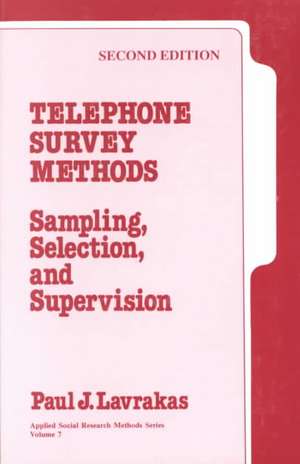Telephone Survey Methods: Sampling, Selection, and Supervision: Applied Social Research Methods, cartea 7
Autor Paul J. Lavrakasen Limba Engleză Paperback – 18 aug 1993
Din seria Applied Social Research Methods
- 26%
 Preț: 515.91 lei
Preț: 515.91 lei -
 Preț: 323.97 lei
Preț: 323.97 lei - 26%
 Preț: 518.12 lei
Preț: 518.12 lei - 22%
 Preț: 391.72 lei
Preț: 391.72 lei - 22%
 Preț: 391.85 lei
Preț: 391.85 lei -
 Preț: 457.79 lei
Preț: 457.79 lei - 15%
 Preț: 604.85 lei
Preț: 604.85 lei - 15%
 Preț: 605.03 lei
Preț: 605.03 lei - 20%
 Preț: 610.14 lei
Preț: 610.14 lei - 20%
 Preț: 610.80 lei
Preț: 610.80 lei - 15%
 Preț: 547.75 lei
Preț: 547.75 lei - 18%
 Preț: 786.24 lei
Preț: 786.24 lei - 15%
 Preț: 548.57 lei
Preț: 548.57 lei - 15%
 Preț: 604.71 lei
Preț: 604.71 lei - 15%
 Preț: 547.75 lei
Preț: 547.75 lei - 15%
 Preț: 549.22 lei
Preț: 549.22 lei - 15%
 Preț: 547.43 lei
Preț: 547.43 lei - 15%
 Preț: 550.06 lei
Preț: 550.06 lei - 20%
 Preț: 551.90 lei
Preț: 551.90 lei -
 Preț: 314.78 lei
Preț: 314.78 lei -
 Preț: 465.49 lei
Preț: 465.49 lei - 20%
 Preț: 608.46 lei
Preț: 608.46 lei - 15%
 Preț: 613.54 lei
Preț: 613.54 lei - 15%
 Preț: 549.05 lei
Preț: 549.05 lei - 15%
 Preț: 602.08 lei
Preț: 602.08 lei - 15%
 Preț: 606.51 lei
Preț: 606.51 lei - 15%
 Preț: 549.22 lei
Preț: 549.22 lei - 20%
 Preț: 552.71 lei
Preț: 552.71 lei - 15%
 Preț: 550.06 lei
Preț: 550.06 lei - 15%
 Preț: 604.20 lei
Preț: 604.20 lei - 15%
 Preț: 605.36 lei
Preț: 605.36 lei - 15%
 Preț: 548.08 lei
Preț: 548.08 lei - 15%
 Preț: 606.15 lei
Preț: 606.15 lei - 15%
 Preț: 605.18 lei
Preț: 605.18 lei - 15%
 Preț: 611.09 lei
Preț: 611.09 lei - 15%
 Preț: 546.45 lei
Preț: 546.45 lei - 18%
 Preț: 716.88 lei
Preț: 716.88 lei - 15%
 Preț: 438.13 lei
Preț: 438.13 lei - 20%
 Preț: 553.37 lei
Preț: 553.37 lei - 18%
 Preț: 717.66 lei
Preț: 717.66 lei
Preț: 550.53 lei
Preț vechi: 647.67 lei
-15% Nou
Puncte Express: 826
Preț estimativ în valută:
105.34€ • 110.28$ • 87.16£
105.34€ • 110.28$ • 87.16£
Carte tipărită la comandă
Livrare economică 07-21 aprilie
Preluare comenzi: 021 569.72.76
Specificații
ISBN-13: 9780803953079
ISBN-10: 0803953070
Pagini: 192
Dimensiuni: 140 x 216 x 14 mm
Greutate: 0.27 kg
Ediția:Second Edition
Editura: SAGE Publications
Colecția Sage Publications, Inc
Seria Applied Social Research Methods
Locul publicării:Thousand Oaks, United States
ISBN-10: 0803953070
Pagini: 192
Dimensiuni: 140 x 216 x 14 mm
Greutate: 0.27 kg
Ediția:Second Edition
Editura: SAGE Publications
Colecția Sage Publications, Inc
Seria Applied Social Research Methods
Locul publicării:Thousand Oaks, United States
Cuprins
INTRODUCTION
Total Survey Error
Telephone Surveying in Perspective
The Telephone Phenomenon in the United States
Basic Steps in the Telephone Survey Process
Computer-Assisted Telephone Interviewing (CATI)
Contents and Organization of This Text
Additional Sources of Instruction on Survey Methodologies
Exercises
GENERATING TELEPHONE SURVEY SAMPLING POOLS
Choosing a Valid Sampling Design
Random Digit Dialing (RDD)
Directory and List-Based Sampling Pools
Mixed Mode Sampling Pools
Sampling Pool Size
Exercises
PROCESSING TELEPHONE SURVEY SAMPLING POOLS
Issues in Controlling the Sampling Pool
Using the Call-Sheet to Control the Sampling Pool
Refusal Report Form, Refusal Conversions, and Nonresponse Error
Expectations in Processing Sampling Pools
Sampling Pool Dispositions and Survey Response and Nonresponse Rates
Sampling Pools in Mixed Mode Surveys
Processing Sampling Pools with CATI
Exercises
SELECTING RESPONDENTS AND SECURING COOPERATION
Starting Off on a Solid Footing
Introducing the Survey
Respondent Selection and Screening Techniques
Advance Contract of Respondents
Exercises
SUPERVISION I
STRUCTURING INTERVIEWERS' WORK
Quality Control in Telephone Versus Personal Interviewing
Recruitment and Hiring of Interviewers
Training Sessions
Presurvey Practice and On-the-Job Training
Total Survey Error and the Interviewer
Exercises
SUPERVISION II
STRUCTURING SUPERVISORY WORK
Staffing and Scheduling Interviewing Sessions
Interviewing Session Setup
Supervising Interviewing Sessions in PAPI and CATI Surveys
Verifying Completed Interviews
Conclusion
Exercises
Total Survey Error
Telephone Surveying in Perspective
The Telephone Phenomenon in the United States
Basic Steps in the Telephone Survey Process
Computer-Assisted Telephone Interviewing (CATI)
Contents and Organization of This Text
Additional Sources of Instruction on Survey Methodologies
Exercises
GENERATING TELEPHONE SURVEY SAMPLING POOLS
Choosing a Valid Sampling Design
Random Digit Dialing (RDD)
Directory and List-Based Sampling Pools
Mixed Mode Sampling Pools
Sampling Pool Size
Exercises
PROCESSING TELEPHONE SURVEY SAMPLING POOLS
Issues in Controlling the Sampling Pool
Using the Call-Sheet to Control the Sampling Pool
Refusal Report Form, Refusal Conversions, and Nonresponse Error
Expectations in Processing Sampling Pools
Sampling Pool Dispositions and Survey Response and Nonresponse Rates
Sampling Pools in Mixed Mode Surveys
Processing Sampling Pools with CATI
Exercises
SELECTING RESPONDENTS AND SECURING COOPERATION
Starting Off on a Solid Footing
Introducing the Survey
Respondent Selection and Screening Techniques
Advance Contract of Respondents
Exercises
SUPERVISION I
STRUCTURING INTERVIEWERS' WORK
Quality Control in Telephone Versus Personal Interviewing
Recruitment and Hiring of Interviewers
Training Sessions
Presurvey Practice and On-the-Job Training
Total Survey Error and the Interviewer
Exercises
SUPERVISION II
STRUCTURING SUPERVISORY WORK
Staffing and Scheduling Interviewing Sessions
Interviewing Session Setup
Supervising Interviewing Sessions in PAPI and CATI Surveys
Verifying Completed Interviews
Conclusion
Exercises
Notă biografică
Paul J. Lavrakas, PhD, is a Research Psychologist and Research Methodologist consultant. He served as Chief Research Methodologist for Nielsen Media Research from 2000-2007. Before joining Nielsen, he was a Full Professor at Northwestern University (1978-1996) and Ohio State University (1996-2000), as well as the founding faculty director of the survey centers at both universities. He is the author of Telephone Survey Methods: Sampling, Selection, and Supervision (2nd Edition, SAGE, 1993) and four other books covering election polling and the news media, as well as numerous other methodological and substantive publications and conference papers.
Descriere
What quality control methods can be used most effectively to structure and monitor interviews and convert refusals? What telephone numbers should be used in random digit dialling? How can eligible respondents be chosen and their cooperation secured? Addressing these and other survey issues, this book offers researchers a guide to thinking about and executing telephone surveys from generating phone numbers to structuring the work of interviewers and supervisors. New to this edition are a focus on the total survey error concept, a comparison of CATI (computer-assisted telephone interviews) with PAPI (paper and pencil inventory) procedures, mixed-mode surveys and new telecommunication technologies. In addition, the book covers such topics as h











